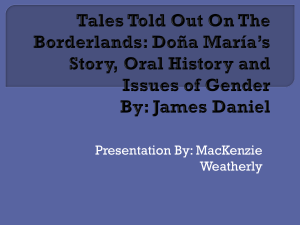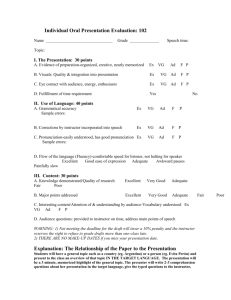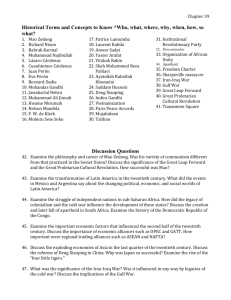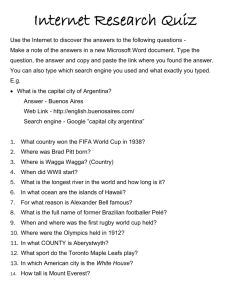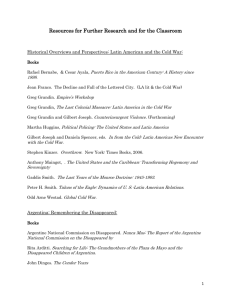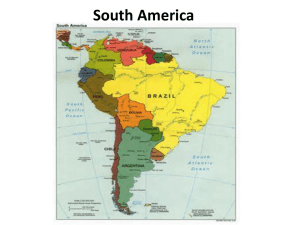Armed Insurrection and Peronism:
advertisement
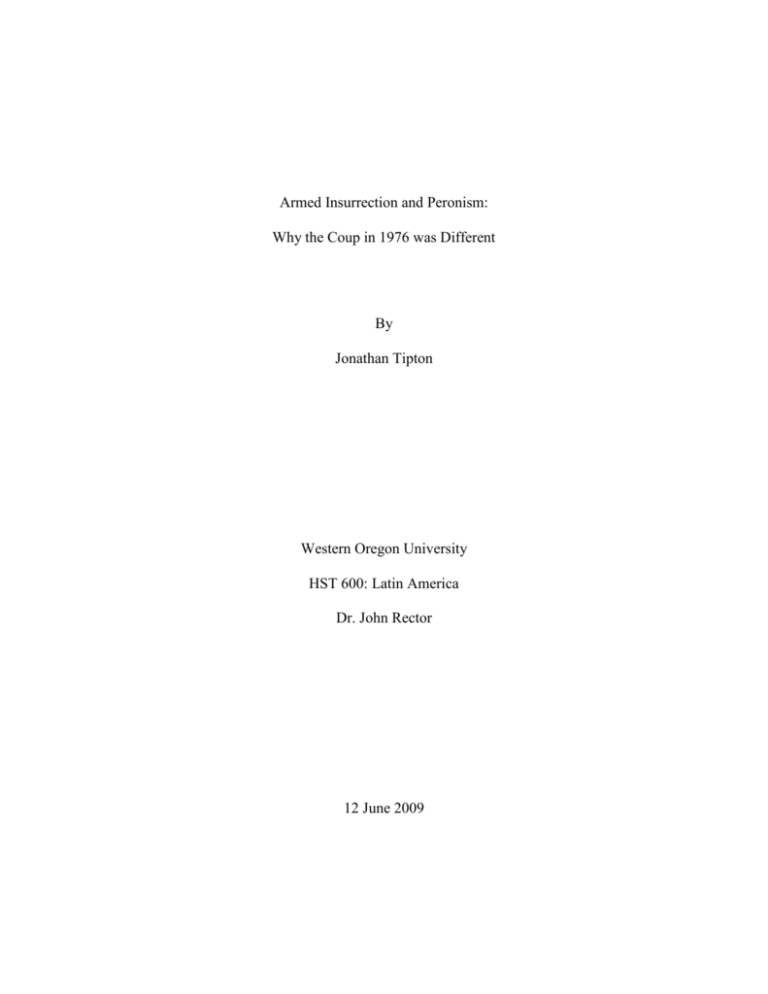
Armed Insurrection and Peronism: Why the Coup in 1976 was Different By Jonathan Tipton Western Oregon University HST 600: Latin America Dr. John Rector 12 June 2009 Different nations rely on different mechanisms in their government for different things. In Argentina an unusual situation exists. The Argentine people relied not on the rule of law but on the competence of their armed forces. That is, the Argentine military was expected to intervene and govern when there were significant problems with the civilian governments. Between the years of 1930 and 1976, the Argentine military took power seven different times. The perpetual threat that existed from this was viewed as a calming influence rather than a destabilizing one. The Argentine people knew that if nothing else, their military would make things right. With this in mind it is important to understand that the military had always tried to return the government to civilian control. The military intervention in 1976 was different than the others. It was different firstly because the military had no intention of leaving power once the situation had been stabilized, and secondly because the military planned to impose order through violence. The military action in 1976 was caused by a confluence of unique circumstances that had not previously existed and resulted in unique action by the Argentine military. By examining specific factors the basis of the military’s action can be clearly understood. The first factor that needs to be addressed is understanding the tradition of intervention, why it had happened in the past and what subsequent events followed. The next idea was the way that Juan Perón permanently changed Argentine politics. Perón’s role in advocating violence as a means of resolving disputes rather than the political process was the next unique circumstance. The inability of the military government to overcome Perón’s political changes through nonviolent means from 1966-1973 was also a significant factor. Finally, the actions taken by Perón and his successor, Isabel, from 1973-1976 enabled a cycle of escalating violence. When all of these are taken together it becomes clear that 1976 was different than previous years and would lead to a unique outcome. Much of the work by other authors on the subject does not fully link the contributing factors. Most authors instead focus on the shorter term issue of the changes by the groups in their targeting of the military and police as the basis for the reciprocal violence. David Rock in his work Authoritarian Argentina describes it “As the violence and chaos mounted, the military, which had become the main target of the guerilla groups, bided its time and waited for an opportunity to deal the death blow against ‘subversion.’”1 By simplifying the issue into one of simply waiting for an opportunity to strike back albeit in a significant way, Rock does not address the deeper causes. Richard Gillespie notes in his work that while the Montoneros had expected the military coup, they had not expected the subsequent actions by the security apparatuses and the means that they then pursued.2 It was expected to be a short term event taking place and then moving on, rather than a sustained campaign of significant brutality that had roots much deeper than previously acknowledged. With these shortcomings in mind it is necessary to examine the deeper causes of the military’s actions between 1976 and 1983. The first key element to understanding the coup in 1976 is the previous six coups. In 1930 the decline of the global economy spread to Argentina and the government in turn reduced social services. The masses were very unhappy with this and prompted the Argentine military to seize power and restore social services before leaving power.3 This would set a precedent that 1 David Rock, Authoritarian Argentina: The Nationalist Movement, Its History and Its Impact (Los Angeles: University of California Press, 1993), 223 . 2 Richard Gillespie, Soldiers of Peron: Argentina’s Montoneros (Oxford: Clarendon Press, 1982), 245. 3 David Rock, Argentina: 1516-1987 (Los Angeles: University of California Press, 1987), 217. would be repeated again and again. In 1943, Argentina was suffering economically because of its sympathy for the Axis powers who were by then losing World War II. The result was an unfavorable economic relationship with the United States and Britain, Argentina’s principal markets for their exports, and a general decline in the Argentine economy. The decline fed popular discontent with the government and the military again intervened, this time though holding onto power for a longer period. This was how Juan Perón would eventually become Argentina’s leader. The next coup took place in 1955, again a result of economic decline. Perón had enjoyed a tremendous surplus income but had largely exhausted it by the time the recession occurred in 1955. That problem, coupled with his politics that had offended the elites in society, prompted the military to seize power. In 1962, Argentina’s elected leader Arturo Frondizi, in the midst of significant economic problems, agreed to work in conjunction with the Peronists. To the dismay of the military, the Peronists were very successful in the elections. The military wanted Frondizi to annul the results, when he refused, he was forced from power.4 This again was the result of economic problems, but this time the political preference of the military was another component. In 1966, the economy’s brief recovery was again threatened. Perón, who was manipulating Argentine politics from exile in Madrid, attempted to undermine the government and exploit its internal divisions. The military arrested one of its own officers, one who had specifically been opposed to military rule, believing only in civilian role of the government. When the current President, President Illia ordered him released, this proved to be the spark that again led to the military revolting. Again, economic problems were significant, but the preference of the military is seen as a driving factor. Finally, in 1976 the military seized power in 4 Ibid., 342. Argentina for the final time. The situation in 1976 was one of a rapidly declining security situation as well as a declining economic situation. The masses again, wanted the military to intervene on their behalf. The history of Argentines relying on their military to care for their country during periods of distress seems counterintuitive to outside examiners, but was perfectly normal for them. The Argentines believed in the professionalism of their military to handle crises and then prepare the following government for success. This happened with some variation following each of their seizures of power except in 1976. The role that Perón had in Argentine politics cannot be understated. During his first time in power he was able to change a large segment of the population’s lives in a meaningful way. His effect was so dramatic that Peronism became synonymous with populism. A review of his regime and its lasting effect is important to understanding future changes of Argentina. Perón’s place in Argentine history is undeniable. The military governments later targeted him and the embodiment of his political idea. Perón represented the success of populism to the majority of the Argentine population, which was why they were such enthusiastic supporters. The military took issue with the new role of Peronism, believing in their own superiority. Perón was able to create a broad and intense following among the Argentine people making him a defining force in Argentine politics from his first election in 1946 until the present day. Perón had such a following that his leadership went on to become the ideal of what an Argentine leader should be. Perón undeniably had widespread appeal. Beginning with his work as the minister of labor, he created a unique relationship between himself and organized labor. Daniel James in his work “Perón and the People” explains: “The relationship between workers and their organizations and the Peronist movement … has generally been taken as defining the uniqueness of Peronism within the spectrum of Latin American populist experiences.”5 The degree of interconnectedness between Perón and organized labor is difficult to understate. Perón specifically and meticulously cultivated their relationship and in return they served as a very powerful base of support for Perón as an individual. Perón in his role as war minister was able to halt an initial coup before it gained any traction. The military leaders were arrested and imprisoned. Perón’s response to the ongoing threat was two-fold. He gave speeches explaining the situation. From his perspective, freedoms were dramatically curtailed, and dissent was totally suppressed. This lasted only briefly. President Farrell met at the insistence of army officers and jointly decided that Perón would be forced to resign on October 9th. The president’s fear that Perón would become a martyr for the opposition led him to order Perón arrested on October 13th. This proved to be a powerful catalyst for movement against the government. Perón’s supporters began assembling en masse and marched on the city beginning on the 17th. General Avalos the new war minister did not recognize the seriousness of the situation and reacted slowly, even as the various police forces made it clear that they would not oppose the crowds. By the afternoon of the 17th it was apparent that General Avalos would not use force to suppress the crowds, and as a result agreed to enter into negotiations with Perón. Perónist allies worked as intermediaries, leading to Perón’s release and eventual address alongside President Farrell from the Casa Rosada and having the crowd peacefully disperse following the ouster of the war and navy ministers. Perón also agreed to 5 Daniel James, Perón and the People in The Argentina Reader, ed. Gabriela Nouzeilles and Graciela Montaldo (Durham : Duke University Press, 2002), 278. participate in elections the following February. However, it was clearly observed that he was already in power.6 With his position well in hand Perón proceeded to campaign for himself in the upcoming election. It should be noted that while Perón enjoyed a tremendous amount of popularity, the election was still contested and there were sectors of the population against him. One such element was the United States diplomatic representative, Spruille Braden. Braden openly argued for the opposition. Perón, being the shrewd politician, used Braden’s endorsement against his rival. Perón turned the contest not into a question of two Argentines, but into a contest of himself against Braden.7 Perón went on to win the election with 52.4 percent. His portrayal of himself as an alternative to Braden seemingly was the decisive factor. Perón won because he was enthusiastically supported by labor interests. He was not popular with the middle class. He was not popular with the upper class. He was detested by industrial owners. The military was divided over its support for him, with officers largely following their social roots. Perón won because of the intense support of the labor groups. To them, Perón was their representative. Perón was the voice of the poor worker. He represented a better quality of life for them and as a result earned their votes on a resounding scale. His main priority once he took office would be to cultivate their personal loyalty. Perón went on to enjoy a period of great economic wealth in Argentina. Assets previously frozen because of Argentina’s limited stance against Germany during World War II were released. Perón would put those assets to use. He dramatically expanded social security and welfare programs, in the process reinforcing the loyalty of the people that elected him and 6 Robert A. Potash, The Army and Politics in Argentina: 1928-1945 (Stanford: Stanford University Press, 1969), 281. 7 Robert A. Potash, The Army and Politics in Argentina: 1945-1962 (Stanford: Stanford University Press, 1980), 43. earning himself demigod status. However, the supply of additional money was limited. Eventually, Perón’s success would taper and fade completely. Perón, just as leaders before him, began to see financial reserves dwindle as the Argentine economy cyclically declined. 8 Perón was different from many of the other politicians at the time. The key difference between him and the others was that when he promised things, he usually accomplished them, which gave him a significant degree of credibility. This resulted in his initial successes in 1945 and 1946. During that period he promised quantifiable and deliverable changes.9 Much of that time was when Perón was operating on behalf of the government, making agreements that were designed to be popular among the broader public. Perón was the public face for those agreements and as a result was widely credited for their creation. Perón represented tangible change for people who were desperate for improvements in their individual lives. His ability to impact those individuals won their loyalty in a lasting way. Perón was also a shrewd politician; He clearly understood the benefits of widespread appeal. Perón played upon class hostilities. The needs of rural workers as well as urban workers were stressed in these talks, and Perón now proclaimed land reform as a goal to be achieved along with social security. He did not hesitate to employ Marxist language, as when he told the food workers: “The Secretariat of Labor and Welfare will pass into history as the magnificent bridge for the evolution of the bourgeoisie into the rule into the rule of the masses.”10 While still a minister in the government, Perón’s popularity grew more and more as the rest of the government’s credibility declined. Perón claimed that he wanted free elections, as was the government’s stance, but at the same time effectively made himself a candidate by emphasizing 8 Potash, 1928, 170. 9 James, Perón, 287. 10 Potash, 1928, 259-60. the effectiveness of the ministry that he represented.11 The corresponding result was that Perón became more and more a popular figure. Public demonstrations actively argued for Perón to become involved: “‘Perón Presidente! Perón sí, otro nó! Perón, Perón, veinte años con Perón!’”12 Perón’s popularity was sufficient not only based on his own actions but also, the limited popularity of his rivals. The importance of María Eva Duarte de Perón (Evita) to her husband’s government also bears addressing. The size of her role corresponded to the relative success and popularity of her husband. This is particularly important when looking at her activities in relation to her foundation, the “Eva Perón Foundation.” Her foundation provided extensive social services to the poor. Nicolas Fraser explains the importance of Evita and her foundation: “the Foundation was extraordinarily successful. Nobody who came into contact with any of Evita’s works was allowed to forget how grateful they should be for what they received.”13 Things began to change when in 1952 Evita died. Her death proved to be a devastating blow to Perón’s government. Inflation began to be out of control, a five year industrial plan was implemented and there was widespread dissatisfaction. Perón became increasingly polarizing without Evita by his side. His ability to maneuver politically did not endear him to everyone. “Both Avalos and Giovanni cited Perón’s constant resort to deceits and ruses, his failure to live up to comradely principles, his betrayal of the esprit de corps… Perón’s indifference to this particular military tradition provoked many of his comrades.”14 Perón had essentially had chosen his path. His 11 Ibid., 260. 12 Ibid., 260. 13 Nicholas Fraser and Marysa Navarro, Eva Perón (New York: WW Norton and Company, 1985), 131. 14 Potash, 1928, 262. abandonment of his comrades in favor of the masses had given him only one future. Perón had chosen to become a politician, believing it to be more likely to succeed than maintaining a subordinate relationship as a member of the military. This is particularly important because it gives a glimpse of Perón’s decision making. Perón saw himself as a political force and was willing to risk his military career on that belief it. In 1955, after seeing his nation enter into economic decline, and the consolidation of opposition groups triggered by a conflict with the Catholic Church, the military attempted a coup against Perón. Their coup was initially carried out in June 1955, it was popular, but it was not well organized or willing to inflict mass bloodshed and as a result failed. The military was galvanized by their taste of success and in turn planned another attempt. Perón ostensibly had agreed to resign, with the date set for August 31, 1955. Rather than give his resignation to the congress, though, he agreed to give it to members of his organization. That night he addressed the assembled crowd: With our exaggerated tolerance, we have won the right to repress them violently. And from now on we establish as a permanent rule for our movement: whomever in any place tries to disturb order against the constituted authorities or against the law or the Constitution may be killed by any Argentine. This rule which every Peronist is to follow is directed not only against those who carry out violence, but also against those who conspire and incite… The watchword for every Peronist, whether alone or within an organization, is to answer a violent act with another more violent. And whenever one of us falls, five of them will fall.15 Perón knew that he was on his way out, but was angry about it and wanted the officers confronting him to pay a high price for their insubordination. He incited his followers to violence. This is widely held as the origin of the armed groups that would later oppose future government. The speech also spread resolve in the armed forces to oppose Perón. Seeing him 15 Potash, 1945, 195. urge his political allies to carry out violent acts against them left them little choice but to oppose him. The next coup began on September 16th in Cordoba. Three days later, Perón submitted an ambiguous letter to the military who interpreted Perón’s offer to resign as an exchange for peace. The rebel forces therefore paused their advance after receiving the news that Perón would resign. Observers have debated whether or not the military intended to allow Perón to flee.16 In any case, the military was once again in power. It had acted to restore economic stability, rather than opposing political ideology. For the military, it was doing what it believed to be in the best interest of the country, but for Perón’s supporters it was a call to action. Perón’s fall was precipitated but a number of judgment errors. In his waning days, a number of comparatively small judgment errors combined in a way that led to his ouster. Perón attacked many of society’s elites and actively challenged the Catholic Church. In June 1955, ambitious military officers attempted a coup against Perón that was subsequently suppressed. On August 31, 1955, Perón gave a speech which advocated vicious violence in the event of civil war. Finally, fifteen days later, on September 16th General Lonardi, whom Perón had forced to retire, led military forces against him executing a much more systemic approach that would eventually force Perón to resign and flee Argentina on September 19, 1955. With his departure from power the immediate threat posed by Perón was gone. However, a new much more complicated threat emerged with the creation and prominence of a number of armed guerilla groups. The new President, General Lonardi, moved quickly to consolidate his power. Potash observes: “Reliable totals are not available, but it is clear that as of early 1956 hundreds of 16 Potash, 1945, 205. officers were affected and possibly over 1,000 were forced into retirement. Noncommissioned officers, whose loyalty to Perón had been demonstrated in the past, were also forced out of the service in a wholesale manner.”17 Without realizing the future consequences, Lonardi was providing the nascent armed groups a cadre of professional leaders who were well trained and extremely motivated. Lonardi’s successor, General Aramburu took it one step further: Within two days of taking power and confronted with a general strike ordered by Peronist leadership of the CGT, declared this an illegal stoppage and called for the intervention of that national trade union body. Authority over the CGT was entrusted to a military interventor, Navy Captain Alberto Patrón, who in turn was empowered to designate military interventors for its affiliated unions. The government’s policy was to encourage the emergence of an anti-Peronist trade union leadership, while reducing the political power of the labor movement as a whole.18 General Aramburu chose the seemingly easy choice, trying to marginalize the opposition rather than opening a legitimate dialogue with them. Aramburu was in effect providing the guerilla groups with individuals who were talented at securing the support of individuals and ensuring solidarity. As time progressed, some political reforms were made, left leaning groups were included, a transition to a civilian government took place, and there seemed to be a generally amicable political situation. As conditions again worsened toward the end of the 1960s, the government took steps to exclude Peronist parties from elections. This exclusion motivated many of the rebel groups. Their organization had been directly challenged by the national government. Given their military background, they believed that “The only orthodoxy is combat.”19 The Peronists saw themselves being unfairly isolated and at their exiled leader’s behest took up violence against the state. 17 Potash, 1945, 215. 18 Potash, 1945, 228. 19 Gillespie, Soldiers, 41. Richard Gillespie explains the situation well: “The Montoneros arrived on the Argentine political scene during some of the stormiest years of social conflict ever experienced by their country.”20 The Montoneros announced their existence to the world in May of 1970. The impetus for their creation was the usurpation of power by General Onganía in 1966. The Montoneros formed in 1968 and spent two years planning and accumulating resources before publicly announcing their existence. They chose the most dramatic act that they could think of to attract national attention. On May 29, 1970, they kidnapped, tried, and later executed General Aramburu.21 The Montoneros chose this for three reasons: to give their organization public exposure, to punish General Aramburu for his role deposing Perón and for his subsequent treatment of Evita’s body, and to prevent Aramburu from conspiring against the Onganía government. The Montoneros while not friends of Onganía, liked Aramburu less. The group enjoyed success in accomplishing all of its objectives through this act. The Montoneros carefully planned future operations. They based much of their planning on the successes of an Uruguayan group the Tupamaros.22 They studied what the Tupamaros had done during their first armed takeover of a town. Then they repeated it in Argentina, when they seized the town of La Calera in the Cordoba province. By all accounts the raid was very successful. It was only when they tried to leave La Calera that some of the group’s founding members were captured and others killed. As time progressed amid other setbacks the Montoneros learned the hard way about having proper security as well as compartmentalizing information. They focused more on creating an organization and recruiting for the organization. 20 Ibid., 47. 21 Ibid., 89. 22 Ibid., 96. It is important to note that the Montoneros had clearly defined goals during the first years. They accumulated resources and publicly undermined the government’s ability to enforce law and order. It is also important to note that “There were no assaults on military garrisons and no instances of Montonero commandos deliberately attacking the army or police.”23 While undermining government authority, the Montoneros focused on winning and maintaining popular support. The end result of the guerilla movements during the period was that they embarrassed the government, while putting additional pressure on the military to leave office in an expeditious manner. But it was not until 1973 that the military left. Peronist, Héctor Cámpora, was elected and formally inaugurated as President of the Argentine Republic. After an eighteen year absence, Peronism returned to power in Argentina. Subsequently, and as a direct result of the guerilla groups pressuring the military government, Perón himself returned to Argentina on June 20, 1973. It is important to note that Argentina was very different when Perón returned. The country was politically fragmented, had significant economic problems, and had an active guerilla movement. Perón was not explicitly committed to the ideals of the guerillas, rather he wanted to use them as a part of a political movement. First and foremost Perón was dedicated to winning and holding the support of the labor organizations. He believed that his future was tied more closely to them. Gillespie explains it well: “Once back in power, Perón, while not ideally seeking to keep his Movement united, was not bent upon retaining the adhesion of the 23 Ibid., 111. radicalized wing at all costs, so long as he could … control the labour movement.”24 Given this perspective, the actions of Perón appear in a somewhat different light. For Perón, guerillas represented a tactic to return to power. Once in the presidency again he repeatedly made comments that were designed to marginalize the guerilla movements as being immature and having unrealistic goals. On August 2, 1973 he addressed a meeting of provincial governors: Juvenile delinquency has flourished in a spectacular way in our country, and this is one of the most telling indices of what has happened to the destruction of man. Administrative procedures, with all the deformities that each governor must have encountered in his province, indicate another sector of the decomposition. Ideological deviation and the growth of the far left are no longer tolerated even on the far left… All of these are signs of the decay of man, which is the most serious thing that could have happened in our country… Our young people are marvelous, but watch out because they could head off in the wrong direction! Making sure that they don’t is our obligation, our task.25 Perón would further expand on his criticism later in the address: Guerillas whom we have seen at work everywhere… that is a matter that the law cannot tolerate, and that, consequently, we cannot tolerate. We have no objection if a political party—whether called Communist, ERP, or whatever—wants to operate within the law, as we are doing. Neither do we have any fears if it operated outside of the law, but it is not the proper thing for a government. We have already seen guerillas function in other places, and they do not behave properly. When something happens outside the law, it is a matter for the courts and the police.26 Perón acknowledged that the armed groups were an important part of his return to power, but disavowed their actions as those of irresponsible children. Perón was trying to move on from the divisive violence that had become commonplace. This combative tone that he took forced them 24 Ibid., 136. Juan Domingo Perón, “Antirevolutionary Peronism,” in The Argentina Reader: History, Culture, Politics, eds Gabriela Nouzeilles and Graciela Montaldo (Durham, NC: Duke University Press, 2002), 389. 25 26 Ibid., 391. to assert themselves through secretive operations rather than existing as legitimate political organizations. Gary W. Wynia explains it well: “At long last it became clear to the Montoneros that Perón had abandoned them.”27 This was the beginning of the radicalization of the armed groups that would cause vicious violence in contrast to their previous actions. Perón’s presidency did not last long. He died on July 1, 1974. Perón intended his policies to continue, because as vice-president, Isabel replaced him. Nevertheless, his movement lost its symbolic leader. With his death, the ideal of Peronism that had been created in the Argentine people’s mind, specifically that of his success, when he was first president, could endure. Isabel Perón, his vice-president and widow, continued his policies. Her performance was not then necessarily associated with the ideal of Peronism. Isabel Perón had never before held political office when her husband had chosen her to be his vice-president. She was selected essentially so that Perón would not have any close rivals. Assuredly, Isabel would agree with what her husband said and did. While Isabel was not totally naïve, having communicated many of her husband’s messages while he was exiled in Spain, she still had no independent political standing. This became rapidly evident when her husband died. Isabel lacked the strength of personality to influence the various competing factions, from the military, to the armed guerilla groups, to the labor organizations. Her husband had that ability. He had already controlled the military, was reasserting control of the labor organizations, and was working to marginalize the armed groups. Isabel had no standing with the military: officers had contempt for her. She was also the first female head of state. The labor organizations took the attitude of “what has she done for us?” to which they only answered “nothing.” The armed groups, already unhappy with their diminished standing, saw Isabel as a weak figurehead 27 Gary W. Wynia, Argentina: Illusions and Realities (New York: Holmes and Meier, 1992), 67. responsible for policies contrary to their benefit, not as Perón, who could have claimed authority to direct the groups. The result was increasing labor unrest, which in turn contributed to economic deterioration. The latter in turn contributed to the uneasiness of the military and police, who had seen themselves as a bulwark against economic unrest. Finally, the armed groups led to an increased level of violence. Isabel’s personal assistant, José López Rega dramatically exacerbated the negative environment. López Rega sought to win the conflict with the armed groups by means of violence. Under him, the police and military deliberately sought to kill as many dissidents as possible. This was a dramatic change in policy that would have extremely negative consequences. José López Rega had met Isabel during her trips to Argentina that prepared for her husband’s return. Only at that time he was a police corporal assigned to the presidential residence, the Casa Rosada. He was a strange man, believed to practice the occult. He went from Isabel’s assistant to becoming the Minister of Social Welfare in the government when Perón returned to power. His performance in this capacity, while not bad, failed to live up to the expectations, especially given that Perón himself had previously held that position. After Perón’s death, he became Comisario General, or the director of police forces nationwide. It was in this capacity that he caused untold damage. López Rega created the Alianza Anti-Communista Argentina (AAA).28 This was a statesponsored death squad. It was not endorsed as an official organization, but was staffed by former military and police, and given free access to government equipment. The AAA tried to Government of Argentina, “Biografia de Jose Loepz Rega,” http://www.historiadelpais.com.ar/ (accessed 4 June 2009). 28 solve the problem using violence against the armed groups. Rather than addressing the issue politically, Isabel deferred to López Rega who chose to dramatically escalate the level of violence against the groups, especially the Montoneros. It is particularly important to realize that the Montoneros had not deliberately attacked police or military forces, but only resorted to fighting them when cornered. Now López Rega deliberately tried to corner them. The result was that the Montoneros fought back viciously. In particular they changed their goals from attempting to subvert government authority, to trying to kill the military and police forces: “Vengeance killings now became an integral part of the Montonero repertoire as violence, though still discriminate, became more freely used against people.”29 It is important to note that solely because of López Rega, the Argentine military was placed on a war footing, ruthlessly participating in many of the activities.30 So began “the Dirty War” or as the military called it, “the War Against Subversion.” It would be totally unfair to blame all of the problems on Isabel. It was likely that even if Perón himself had been alive he would have had difficulty dealing with the escalating chaos. The Isabel government inherited significant issues that would go on to incapacitate it. The political scene under the new regime came thus came to resemble an open battle-ground for all the diverse, unresolved conflicts inherited from the previous military regime, plus new contradictions generated by the project to re-enact the populist compromise in a highly inhospitable environment… The state apparatus underwent a rapid process or corrosion and disaggregation leading to the virtual disappearance of state of state autonomy with respect to civil society.31 29 Gillespie, Soldiers, 184. 30 Rock, Argentina, 363. 31 William C. Smith, Reflections on the Political Economy of Authoritarian Rule and Capitalist Reorganization in Contemporary Argentina in Generals in Retreat, eds. Phillip O’Brien and Paul Cammack (Manchester, UK: Manchester University Press, 1985), 46. Argentina was rapidly descending into chaos. In some ways it was Isabel’s responsibility, in other ways, it had been building for a long time. The conditions that existed though for this particular collapse of authority could have occurred in the political vacuum created by the death of Perón. The manner in which events took place could have likely been different if Perón had chosen a vice-president that had had independent political standing. Also, the unfortunate prominence of López Rega certainly influenced the speed that Isabel Perón’s government collapsed. It was with this particular state of civil authority that the Argentine military was working through its own issues about whether to intervene again or to allow the continued decline of the economic and security situations. It is important to remember that when the military had intervened before it was almost exclusively based on popular discontent due to economic problems. In a way, the deteriorating security situation made the military less enthusiastic about seizing power. It did not stop them, however, from eventually overthrowing the civilian leaders. On March 24, 1976, the Argentine military once again seized power. Twenty-one months after Juan Perón died, the military took control. In a radio address the next day, the military actually shared the reasoning process that they used to arrive at their decision: The armed forces have assumed the direction of the state in fulfillment of their unrenounceable obligation. They do so only after calm mediation about the irreparable consequences to the destiny of the nation that would be caused by the adoption of a different stance. This decision is aimed at ending misrule, corruption, and the scourge of subversion… It rejects, therefore, the disruptive actions of all extremists and the corrupting effect of demagoguery… We will continue fighting, without quarter, all forms of subversion, both open and clandestine, and will eradicate all forms of demagoguery.32 Jorge Rafael Videla, EmilioEduardo Massera and Orlando Ramon Agosti, “The Armed Forces’ Decision to Assume the Direction of the State,” in The Politics of Antipolitics, eds Brian Loveman and Thomas M. Davies Jr. (Lincoln, NE: University of Nebraska Press, 1978) 177-178. 32 The language of this text is particularly important. They talked about their obligation to intervene. They mention their goals, the pursuit of the fight against subversion. They very subtly mention that the pursuit of subversives will go on ‘without quarter.’ This is significant because it would predict the actions that they would complete while they held onto power, or the war against the people of Argentina. It is important to maintain perspective on the difference between the actions taken by the military from 1966-1973 compared to 1976-1983. From 1966-1973, the military government fundamentally altered the Argentine economy. It worked to reduce the role of manufacturing in Argentina. The desired and achieved result of this was the substantial weakening of the labor organizations that had been key to Perón’s previous rise to power. The unanticipated side effect though had been an overall deterioration of the Argentine economy. The government had certainly targeted the Peronists, but it had been with economic attacks rather than violence. The conflict between the armed Peronist groups and the state was now evolving again. Rather than being a fight between armed parties deliberately targeting each other, it would now be a deliberate campaign of violence against the activists and their supporters. In the case of the armed Peronists, this would encompass anyone who opposed the military in any manner. The Argentine military was announcing the decision to wage total war against the ‘subversives.’ The goals of the military to fundamentally change their society through violence also contrasted starkly from previous military interventions. The military had always been somewhat wary of assuming control of the civilian government, seeking instead to briefly intervene to establish stability and then leave. While that did not always happen, that was always the presupposed goal. In 1976, the military was taking over to change their society in an irreversible way. This represented a transition toward the use of violence. The military relentlessly pursued its goals once in power. The Argentine military waged state-sponsored terrorism against the Argentine people. The Argentine military created a climate of fear with systemic violence against members of the armed organizations, dissidents, and anyone that was seen as a threat.33 If a person opposed or seemed to oppose the military government between 1976 and 1983, they were tortured, their families were tortured, and many simply ‘disappeared.’ The conduct of the military government is universally viewed as reprehensible. Wynia explains it well: “Argentines were never less fond of their armed forces than in 1983 when they paused to contemplate what their soldiers had done to them during the previous decade. At least 8,000 citizens had been killed by military and paramilitary personnel, most of them in secret after being tortured in detention centers.”34 The Argentine people in particular hold their armed forces responsible for the events that took place during the their government, and to date there has not been any military involvement in civilian government since they left power the last time in 1983. It is important to note that the Argentine military had worked against Peronism since it deposed Perón himself in 1955. With the security situation degraded to the low level that it had by 1976, the military took action to physically destroy Peronism. From 1955-1976 the Argentine military wanted to marginalize Peronism, from 1976-1983 it set out to destroy it. David Rock explains Videla’s declaration after seizing power as the beginning of a new historical cycle.35 The new beginning was a shift from political efforts to ruthless physical destruction of Peronism. Juan E Corradi, “The Culture of Fear in Civil Society,” in From Military Rule to Liberal Democracy in Argentina, eds Monica Peralta-Ramos, and Carlos H Waisman (London: Westview Press, 1987), 113. 33 34 Wynia, Argentina, 72. 35 Rock, Argentina, 368. When the different concepts are taken together, the picture is created of how the coup of 1976 was different. The military tradition of intervention created a basis of justification for a military government. Perón represented such an ideal that he inspired people to believe in him even after more than a decade out of power, those people took up arms to assist in facilitating his return. Perón actually urged armed groups to form and do all that they could to destabilize the state. Perón returned from exile bringing several long unresolved problems to the forefront of political events. Perón’s selection of Isabel as his vice-president despite her unproven political record lacked support sped up the descent into chaos. The role of López Rega under Isabel in escalating the level of violence to the effect that it was at an unprecedented level was a first of its kind series of events. Changing from attempting to undermine political support to embracing the use of gratuitous violence completed the significant factors in the coup of 1976. The goals of the military when they assumed power in 1976 differed from their goals previously when they took power. While there was limited economic progress made following the military taking power in 1976, largely a result of a decreasing will to resist them, it is dramatically outweighed by the negative effects of what they did. Finally, the military followed through on their stated goal of waging a campaign of murder and torture against subversion while they were in power. Taking away any one of the contributing factors, and the outcome of the coup in 1976 and the following years would have been dramatically different. Bibliography Corradi, Juan E. “The Culture of Fear in Civil Society,” In From Military Rule to Liberal Democracy in Argentina, eds Monica Peralta-Ramos, and Carlos H Waisman, London: Westview Press, 1987. Flaskamp, Carlos, Organizaciones Politico-Militares: Testimonio de la Lucha Armada en la Argentina (1968-1976). Buenos Aires: Ediciones Nuevos Tiempos, 2002. Fraser, Nicholas and Marysa Navarro, Eva Perón. New York: WW Norton and Company, 1985. Gillespie, Richard. Soldiers of Peron: Argentina’s Montoneros. Oxford: Clarendon Press, 1982. Government of Argentina, “Biografia de Jose Loepz Rega,” http://www.historiadelpais.com.ar/ (accessed 4 June 2009). James, Daniel. “Perón and the People” in The Argentina Reader. eds. Gabriela Nouzeilles and Graciela Montaldo, Durham : Duke University Press, 2002. Larraquy, Marcelo, Lopez Rega: La Biografia. Buenos Aires: Editorial Sudamericana, 2004. Lewis, Daniel K. The History of Argentina. London: Greenwood Press, 2001. Loveman, Brian and Thomas M Davies Jr, Eds. The Politics of Antipolitics: The Military in Latin America. Lincoln, NE: University of Nebraska Press, 1997. Norden, Deborah. Military Rebellion in Argentina. Lincoln, NE: University of Nebraska Press, 1996. Perón, Juan Domingo “Antirevolutionary Peronism,” in The Argentina Reader: History, Culture, Politics, eds Gabriela Nouzeilles and Graciela Montaldo. Durham, NC: Duke University Press, 2002. Potash, Robert A. The Army and Politics in Argentina: 1928-1945. Stanford: Stanford University Press, 1969. -----. The Army and Politics in Argentina: 1945-1962. Stanford: Stanford University Press, 1980. Rock, David, Argentina: 1516-1987. Los Angeles: University of California Press, 1987. -----. Authoritarian Argentina: The Nationalist Movement, Its History and Its Impact. Los Angeles: University of California Press, 1993. Smith, William C. “Reflections on the Political Economy of Authoritarian Rule and Capitalist Reorganization in Contemporary Argentina” in Generals in Retreat. eds. Phillip O’Brien and Paul Cammack. Manchester, UK: Manchester University Press, 1985. Videla, Jorge Rafael Emilio Eduardo Massera and Orlando Ramon Agosti, “The Armed Forces’ Decision to Assume the Direction of the State,” in The Politics of Antipolitics. eds Brian Loveman and Thomas M. Davies Jr. Lincoln, NE: University of Nebraska Press, 1978. Wynia, Gary W. Argentina: Illusions and Realities. New York: Holmes and Meier, 1992.
